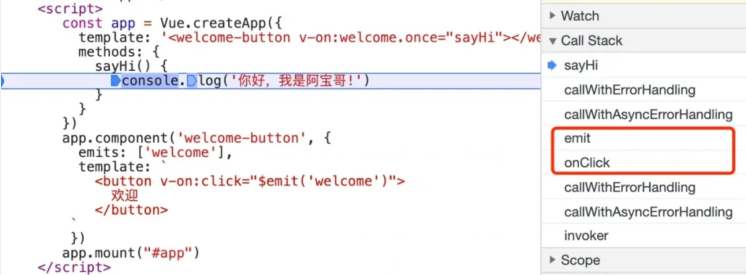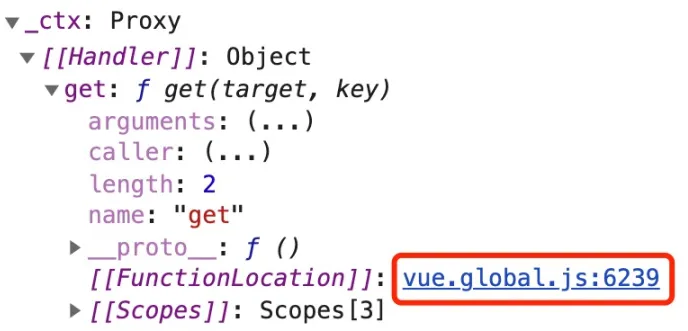这是 Vue 3.0 进阶系列 的第二篇文章,该系列的第一篇文章是 Vue 3.0 进阶之指令探秘。本文阿宝哥将以一个简单的示例为切入点,带大家一起一步步揭开自定义事件背后的秘密。
- <div id="app"></div>
- <script>
- const app = Vue.createApp({
- template: '<welcome-button v-on:welcome="sayHi"></welcome-button>',
- methods: {
- sayHi() {
- console.log('你好,我是阿宝哥!');
- }
- }
- })
- app.component('welcome-button', {
- emits: ['welcome'],
- template: `
- <button v-on:click="$emit('welcome')">
- 欢迎
- </button>
- `
- })
- app.mount("#app")
- </script>
在以上示例中,我们先通过 Vue.createApp 方法创建 app 对象,之后利用该对象上的 component 方法注册全局组件 —— welcome-button 组件。在定义该组件时,我们通过 emits 属性定义了该组件上的自定义事件。当然用户点击 欢迎 按钮时,就会发出 welcome 事件,之后就会调用 sayHi 方法,接着控制台就会输出 你好,我是阿宝哥! 。
虽然该示例比较简单,但也存在以下 2 个问题:
- $emit 方法来自哪里?
- 自定义事件的处理流程是什么?
下面我们将围绕这些问题来进一步分析自定义事件背后的机制,首先我们先来分析第一个问题。
一、$emit 方法来自哪里?
使用 Chrome 开发者工具,我们在 sayHi 方法内部加个断点,然后点击 欢迎 按钮,此时函数调用栈如下图所示:

在上图右侧的调用栈,我们发现了一个存在于 componentEmits.ts 文件中的 emit 方法。但在模板中,我们使用的是 $emit 方法,为了搞清楚这个问题,我们来看一下 onClick 方法:

由上图可知,我们的 $emit 方法来自 _ctx 对象,那么该对象是什么对象呢?同样,利用断点我们可以看到 _ctx 对象的内部结构:

很明显 _ctx 对象是一个 Proxy 对象,如果你对 Proxy 对象还不了解,可以阅读 你不知道的 Proxy 这篇文章。当访问 _ctx 对象的 $emit 属性时,将会进入 get 捕获器,所以接下来我们来分析 get 捕获器:

通过 [[FunctionLocation]] 属性,我们找到了 get 捕获器的定义,具体如下所示:
- // packages/runtime-core/src/componentPublicInstance.ts
- export const RuntimeCompiledPublicInstanceProxyHandlers = extend(
- {},
- PublicInstanceProxyHandlers,
- {
- get(target: ComponentRenderContext, key: string) {
- // fast path for unscopables when using `with` block
- if ((key as any) === Symbol.unscopables) {
- return
- }
- return PublicInstanceProxyHandlers.get!(target, key, target)
- },
- has(_: ComponentRenderContext, key: string) {
- const has = key[0] !== '_' && !isGloballyWhitelisted(key)
- // 省略部分代码
- return has
- }
- }
- )
观察以上代码可知,在 get 捕获器内部会继续调用 PublicInstanceProxyHandlers 对象的 get 方法来获取 key 对应的值。由于 PublicInstanceProxyHandlers 内部的代码相对比较复杂,这里我们只分析与示例相关的代码:
- // packages/runtime-core/src/componentPublicInstance.ts
- export const PublicInstanceProxyHandlers: ProxyHandler<any> = {
- get({ _: instance }: ComponentRenderContext, key: string) {
- const { ctx, setupState, data, props, accessCache, type, appContext } = instance
- // 省略大部分内容
- const publicGetter = publicPropertiesMap[key]
- // public $xxx properties
- if (publicGetter) {
- if (key === '$attrs') {
- track(instance, TrackOpTypes.GET, key)
- __DEV__ && markAttrsAccessed()
- }
- return publicGetter(instance)
- },
- // 省略set和has捕获器
- }
在上面代码中,我们看到了 publicPropertiesMap 对象,该对象被定义在 componentPublicInstance.ts 文件中:
- // packages/runtime-core/src/componentPublicInstance.ts
- const publicPropertiesMap: PublicPropertiesMap = extend(Object.create(null), {
- $: i => i,
- $el: i => i.vnode.el,
- $data: i => i.data,
- $props: i => (__DEV__ ? shallowReadonly(i.props) : i.props),
- $attrs: i => (__DEV__ ? shallowReadonly(i.attrs) : i.attrs),
- $slots: i => (__DEV__ ? shallowReadonly(i.slots) : i.slots),
- $refs: i => (__DEV__ ? shallowReadonly(i.refs) : i.refs),
- $parent: i => getPublicInstance(i.parent),
- $root: i => getPublicInstance(i.root),
- $emit: i => i.emit,
- $options: i => (__FEATURE_OPTIONS_API__ ? resolveMergedOptions(i) : i.type),
- $forceUpdate: i => () => queueJob(i.update),
- $nextTick: i => nextTick.bind(i.proxy!),
- $watch: i => (__FEATURE_OPTIONS_API__ ? instanceWatch.bind(i) : NOOP)
- } as PublicPropertiesMap)
在 publicPropertiesMap 对象中,我们找到了 $emit 属性,该属性的值为 $emit: i => i.emit,即 $emit 指向的是参数 i 对象的 emit 属性。下面我们来看一下,当获取 $emit 属性时,target 对象是什么:

由上图可知 target 对象有一个 _ 属性,该属性的值是一个对象,且该对象含有 vnode、type 和 parent 等属性。因此我们猜测 _ 属性的值是组件实例。为了证实这个猜测,利用 Chrome 开发者工具,我们就可以轻易地分析出组件挂载过程中调用了哪些函数:

在上图中,我们看到了在组件挂载阶段,调用了 createComponentInstance 函数。顾名思义,该函数用于创建组件实例,其具体实现如下所示:
- // packages/runtime-core/src/component.ts
- export function createComponentInstance(
- vnode: VNode,
- parent: ComponentInternalInstance | null,
- suspense: SuspenseBoundary | null
- ) {
- const type = vnode.type as ConcreteComponent
- const appContext =
- (parent ? parent.appContext : vnode.appContext) || emptyAppContext
- const instance: ComponentInternalInstance = {
- uid: uid++,
- vnode,
- type,
- parent,
- appContext,
- // 省略大部分属性
- emit: null as any,
- emitted: null,
- }
- if (__DEV__) { // 开发模式
- instance.ctx = createRenderContext(instance)
- } else { // 生产模式
- instance.ctx = { _: instance }
- }
- instance.root = parent ? parent.root : instance
- instance.emit = emit.bind(null, instance)
- return instance
- }
在以上代码中,我们除了发现 instance 对象之外,还看到了 instance.emit = emit.bind(null, instance) 这个语句。这时我们就找到了 $emit 方法来自哪里的答案。弄清楚第一个问题之后,接下来我们来分析自定义事件的处理流程。
二、自定义事件的处理流程是什么?
要搞清楚,为什么点击 欢迎 按钮派发 welcome 事件之后,就会自动调用 sayHi 方法的原因。我们就必须分析 emit 函数的内部处理逻辑,该函数被定义在 runtime-core/src/componentEmits.t 文件中:
- // packages/runtime-core/src/componentEmits.ts
- export function emit(
- instance: ComponentInternalInstance,
- event: string,
- ...rawArgs: any[]
- ) {
- const props = instance.vnode.props || EMPTY_OBJ
- // 省略大部分代码
- let args = rawArgs
- // convert handler name to camelCase. See issue #2249
- let handlerName = toHandlerKey(camelize(event))
- let handler = props[handlerName]
- if (handler) {
- callWithAsyncErrorHandling(
- handler,
- instance,
- ErrorCodes.COMPONENT_EVENT_HANDLER,
- args
- )
- }
- }
其实在 emit 函数内部还会涉及 v-model update:xxx 事件的处理,关于 v-model 指令的内部原理,阿宝哥会写单独的文章来介绍。这里我们只分析与当前示例相关的处理逻辑。
在 emit 函数中,会使用 toHandlerKey 函数把事件名转换为驼峰式的 handlerName:
- // packages/shared/src/index.ts
- export const toHandlerKey = cacheStringFunction(
- (str: string) => (str ? `on${capitalize(str)}` : ``)
- )
在获取 handlerName 之后,就会从 props 对象上获取该 handlerName 对应的 handler对象。如果该 handler 对象存在,则会调用 callWithAsyncErrorHandling 函数,来执行当前自定义事件对应的事件处理函数。callWithAsyncErrorHandling 函数的定义如下:
- // packages/runtime-core/src/errorHandling.ts
- export function callWithAsyncErrorHandling(
- fn: Function | Function[],
- instance: ComponentInternalInstance | null,
- type: ErrorTypes,
- args?: unknown[]
- ): any[] {
- if (isFunction(fn)) {
- const res = callWithErrorHandling(fn, instance, type, args)
- if (res && isPromise(res)) {
- res.catch(err => {
- handleError(err, instance, type)
- })
- }
- return res
- }
- // 处理多个事件处理器
- const values = []
- for (let i = 0; i < fn.length; i++) {
- values.push(callWithAsyncErrorHandling(fn[i], instance, type, args))
- }
- return values
- }
通过以上代码可知,如果 fn 参数是函数对象的话,在 callWithAsyncErrorHandling 函数内部还会继续调用 callWithErrorHandling 函数来最终执行事件处理函数:
- // packages/runtime-core/src/errorHandling.ts
- export function callWithErrorHandling(
- fn: Function,
- instance: ComponentInternalInstance | null,
- type: ErrorTypes,
- args?: unknown[]
- ) {
- let res
- try {
- res = args ? fn(...args) : fn()
- } catch (err) {
- handleError(err, instance, type)
- }
- return res
- }
在 callWithErrorHandling 函数内部,使用 try catch 语句来捕获异常并进行异常处理。如果调用 fn 事件处理函数之后,返回的是一个 Promise 对象的话,则会通过 Promise 对象上的 catch 方法来处理异常。了解完上面的内容,再回顾一下前面见过的函数调用栈,相信此时你就不会再陌生了。

现在前面提到的 2 个问题,我们都已经找到答案了。为了能更好地掌握自定义事件的相关内容,阿宝哥将使用 Vue 3 Template Explorer 这个在线工具,来分析一下示例中模板编译的结果:
App 组件模板
- <welcome-button v-on:welcome="sayHi"></welcome-button>
- const _Vue = Vue
- return function render(_ctx, _cache, $props, $setup, $data, $options) {
- with (_ctx) {
- const { resolveComponent: _resolveComponent, createVNode: _createVNode,
- openBlock: _openBlock, createBlock: _createBlock } = _Vue
- const _component_welcome_button = _resolveComponent("welcome-button")
- return (_openBlock(), _createBlock(_component_welcome_button,
- { onWelcome: sayHi }, null, 8 /* PROPS */, ["onWelcome"]))
- }
- }
welcome-button 组件模板
- <button v-on:click="$emit('welcome')">欢迎</button>
- const _Vue = Vue
- return function render(_ctx, _cache, $props, $setup, $data, $options) {
- with (_ctx) {
- const { createVNode: _createVNode, openBlock: _openBlock,
- createBlock: _createBlock } = _Vue
- return (_openBlock(), _createBlock("button", {
- onClick: $event => ($emit('welcome'))
- }, "欢迎", 8 /* PROPS */, ["onClick"]))
- }
- }
观察以上结果,我们可知通过 v-on: 绑定的事件,都会转换为以 on 开头的属性,比如 onWelcome 和 onClick。为什么要转换成这种形式呢?这是因为在 emit 函数内部会通过 toHandlerKey 和 camelize 这两个函数对事件名进行转换:
- // packages/runtime-core/src/componentEmits.ts
- export function emit(
- instance: ComponentInternalInstance,
- event: string,
- ...rawArgs: any[]
- ) {
- // 省略大部分代码
- // convert handler name to camelCase. See issue #2249
- let handlerName = toHandlerKey(camelize(event))
- let handler = props[handlerName]
- }
为了搞清楚转换规则,我们先来看一下 camelize 函数:
- // packages/shared/src/index.ts
- const camelizeRE = /-(\w)/g
- export const camelize = cacheStringFunction(
- (str: string): string => {
- return str.replace(camelizeRE, (_, c) => (c ? c.toUpperCase() : ''))
- }
- )
观察以上代码,我们可以知道 camelize 函数的作用,用于把 kebab-case (短横线分隔命名) 命名的事件名转换为 camelCase (驼峰命名法) 的事件名,比如 "test-event" 事件名经过 camelize 函数处理后,将被转换为 "testEvent"。该转换后的结果,还会通过 toHandlerKey 函数进行进一步处理,toHandlerKey 函数被定义在 shared/src/index.ts文件中:
- // packages/shared/src/index.ts
- export const toHandlerKey = cacheStringFunction(
- (str: string) => (str ? `on${capitalize(str)}` : ``)
- )
- export const capitalize = cacheStringFunction(
- (str: string) => str.charAt(0).toUpperCase() + str.slice(1)
- )
对于前面使用的 "testEvent" 事件名经过 toHandlerKey 函数处理后,将被最终转换为 "onTestEvent" 的形式。为了能够更直观地了解事件监听器的合法形式,我们来看一下 runtime-core 模块中的测试用例:
- // packages/runtime-core/__tests__/componentEmits.spec.ts
- test('isEmitListener', () => {
- const options = {
- click: null,
- 'test-event': null,
- fooBar: null,
- FooBaz: null
- }
- expect(isEmitListener(options, 'onClick')).toBe(true)
- expect(isEmitListener(options, 'onclick')).toBe(false)
- expect(isEmitListener(options, 'onBlick')).toBe(false)
- // .once listeners
- expect(isEmitListener(options, 'onClickOnce')).toBe(true)
- expect(isEmitListener(options, 'onclickOnce')).toBe(false)
- // kebab-case option
- expect(isEmitListener(options, 'onTestEvent')).toBe(true)
- // camelCase option
- expect(isEmitListener(options, 'onFooBar')).toBe(true)
- // PascalCase option
- expect(isEmitListener(options, 'onFooBaz')).toBe(true)
- })
了解完事件监听器的合法形式之后,我们再来看一下 cacheStringFunction 函数:
- // packages/shared/src/index.ts
- const cacheStringFunction = <T extends (str: string) => string>(fn: T): T => {
- const cache: Record<string, string> = Object.create(null)
- return ((str: string) => {
- const hit = cache[str]
- return hit || (cache[str] = fn(str))
- }) as any
- }
以上代码也比较简单,cacheStringFunction 函数的作用是为了实现缓存功能。
三、阿宝哥有话说
3.1 如何在渲染函数中绑定事件?
在前面的示例中,我们通过 v-on 指令完成事件绑定,那么在渲染函数中如何绑定事件呢?
- <div id="app"></div>
- <script>
- const { createApp, defineComponent, h } = Vue
- const Foo = defineComponent({
- emits: ["foo"],
- render() { return h("h3", "Vue 3 自定义事件")},
- created() {
- this.$emit('foo');
- }
- });
- const onFoo = () => {
- console.log("foo be called")
- };
- const Comp = () => h(Foo, { onFoo })
- const app = createApp(Comp);
- app.mount("#app")
- </script>
在以上示例中,我们通过 defineComponent 全局 API 定义了 Foo 组件,然后通过 h 函数创建了函数式组件 Comp,在创建 Comp 组件时,通过设置 onFoo 属性实现了自定义事件的绑定操作。
3.2 如何只执行一次事件处理器?
在模板中设置
- <welcome-button v-on:welcome.once="sayHi"></welcome-button>
- const _Vue = Vue
- return function render(_ctx, _cache, $props, $setup, $data, $options) {
- with (_ctx) {
- const { resolveComponent: _resolveComponent, createVNode: _createVNode,
- openBlock: _openBlock, createBlock: _createBlock } = _Vue
- const _component_welcome_button = _resolveComponent("welcome-button")
- return (_openBlock(), _createBlock(_component_welcome_button,
- { onWelcomeOnce: sayHi }, null, 8 /* PROPS */, ["onWelcomeOnce"]))
- }
- }
在以上代码中,我们使用了 once 事件修饰符,来实现只执行一次事件处理器的功能。除了 once 修饰符之外,还有其他的修饰符,比如:
- <!-- 阻止单击事件继续传播 -->
- <a @click.stop="doThis"></a>
- <!-- 提交事件不再重载页面 -->
- <form @submit.prevent="onSubmit"></form>
- <!-- 修饰符可以串联 -->
- <a @click.stop.prevent="doThat"></a>
- <!-- 只有修饰符 -->
- <form @submit.prevent></form>
- <!-- 添加事件监听器时使用事件捕获模式 -->
- <!-- 即内部元素触发的事件先在此处理,然后才交由内部元素进行处理 -->
- <div @click.capture="doThis">...</div>
- <!-- 只当在 event.target 是当前元素自身时触发处理函数 -->
- <!-- 即事件不是从内部元素触发的 -->
- <div @click.self="doThat">...</div>
在渲染函数中设置
- <div id="app"></div>
- <script>
- const { createApp, defineComponent, h } = Vue
- const Foo = defineComponent({
- emits: ["foo"],
- render() { return h("h3", "Vue 3 自定义事件")},
- created() {
- this.$emit('foo');
- this.$emit('foo');
- }
- });
- const onFoo = () => {
- console.log("foo be called")
- };
- // 在事件名后添加Once,表示该事件处理器只执行一次
- const Comp = () => h(Foo, { onFooOnce: onFoo })
- const app = createApp(Comp);
- app.mount("#app")
- </script>
以上两种方式都能生效的原因是,模板中的指令 v-on:welcome.once,经过编译后会转换为onWelcomeOnce,并且在 emit 函数中定义了 once 修饰符的处理规则:
- // packages/runtime-core/src/componentEmits.ts
- export function emit(
- instance: ComponentInternalInstance,
- event: string,
- ...rawArgs: any[]
- ) {
- const props = instance.vnode.props || EMPTY_OBJ
- const onceHandler = props[handlerName + `Once`]
- if (onceHandler) {
- if (!instance.emitted) {
- ;(instance.emitted = {} as Record<string, boolean>)[handlerName] = true
- } else if (instance.emitted[handlerName]) {
- return
- }
- callWithAsyncErrorHandling(
- onceHandler,
- instance,
- ErrorCodes.COMPONENT_EVENT_HANDLER,
- args
- )
- }
- }
3.3 如何添加多个事件处理器
在模板中设置
- <div @click="foo(), bar()"/>
- const _Vue = Vue
- return function render(_ctx, _cache, $props, $setup, $data, $options) {
- with (_ctx) {
- const { createVNode: _createVNode, openBlock: _openBlock,
- createBlock: _createBlock } = _Vue
- return (_openBlock(), _createBlock("div", {
- onClick: $event => (foo(), bar())
- }, null, 8 /* PROPS */, ["onClick"]))
- }
- }
在渲染函数中设置
- <div id="app"></div>
- <script>
- const { createApp, defineComponent, h } = Vue
- const Foo = defineComponent({
- emits: ["foo"],
- render() { return h("h3", "Vue 3 自定义事件")},
- created() {
- this.$emit('foo');
- }
- });
- const onFoo = () => {
- console.log("foo be called")
- };
- const onBar = () => {
- console.log("bar be called")
- };
- const Comp = () => h(Foo, { onFoo: [onFoo, onBar] })
- const app = createApp(Comp);
- app.mount("#app")
- </script>
以上方式能够生效的原因是,在前面介绍的 callWithAsyncErrorHandling 函数中含有多个事件处理器的处理逻辑:
- // packages/runtime-core/src/errorHandling.ts
- export function callWithAsyncErrorHandling(
- fn: Function | Function[],
- instance: ComponentInternalInstance | null,
- type: ErrorTypes,
- args?: unknown[]
- ): any[] {
- if (isFunction(fn)) {
- // 省略部分代码
- }
- const values = []
- for (let i = 0; i < fn.length; i++) {
- values.push(callWithAsyncErrorHandling(fn[i], instance, type, args))
- }
- return values
- }
3.4 Vue 3 的 $emit 与 Vue 2 的 $emit 有什么区别?
在 Vue 2 中 $emit 方法是 Vue.prototype 对象上的属性,而 Vue 3 上的 $emit 是组件实例上的一个属性,instance.emit = emit.bind(null, instance)。
- // src/core/instance/events.js
- export function eventsMixin (Vue: Class<Component>) {
- const hookRE = /^hook:/
- // 省略$on、$once和$off等方法的定义
- // Vue实例是一个EventBus对象
- Vue.prototype.$emit = function (event: string): Component {
- const vm: Component = this
- let cbs = vm._events[event]
- if (cbs) {
- cbs = cbs.length > 1 ? toArray(cbs) : cbs
- const args = toArray(arguments, 1)
- const info = `event handler for "${event}"`
- for (let i = 0, l = cbs.length; i < l; i++) {
- invokeWithErrorHandling(cbs[i], vm, args, vm, info)
- }
- }
- return vm
- }
- }
本文阿宝哥主要介绍了在 Vue 3 中自定义事件背后的秘密。为了让大家能够更深入地掌握自定义事件的相关知识,阿宝哥从源码的角度分析了 $emit 方法的来源和自定义事件的处理流程。
在 Vue 3.0 进阶系列第一篇文章 Vue 3.0 进阶之指令探秘 中,我们已经介绍了指令相关的知识,有了这些基础,之后阿宝哥将带大家一起探索 Vue 3 双向绑定的原理,感兴趣的小伙伴不要错过哟。
四、参考资源
- Vue 3 官网 - 事件处理
- Vue 3 官网 - 自定义事件
- Vue 3 官网 - 全局 API


























